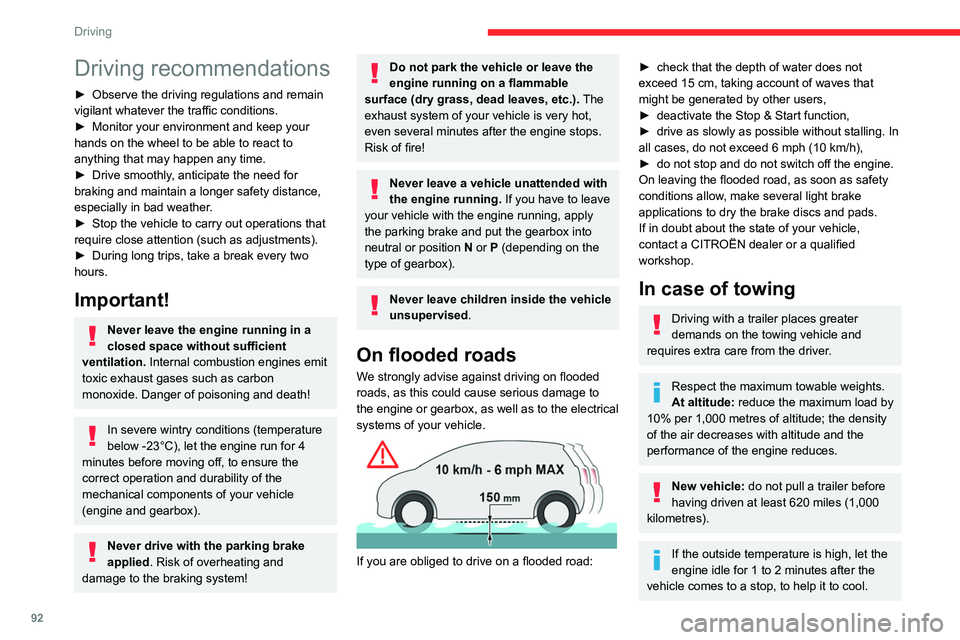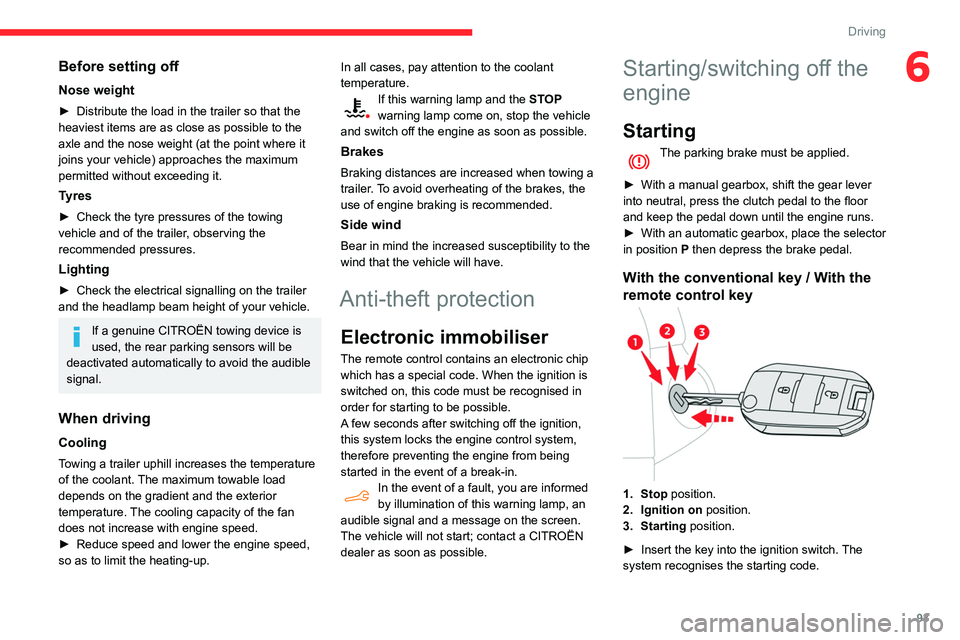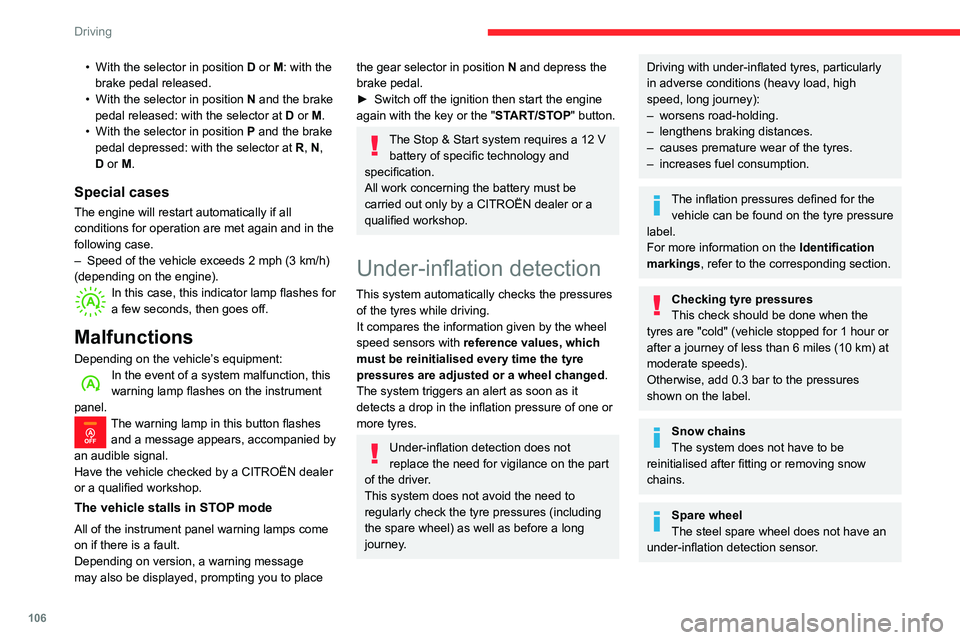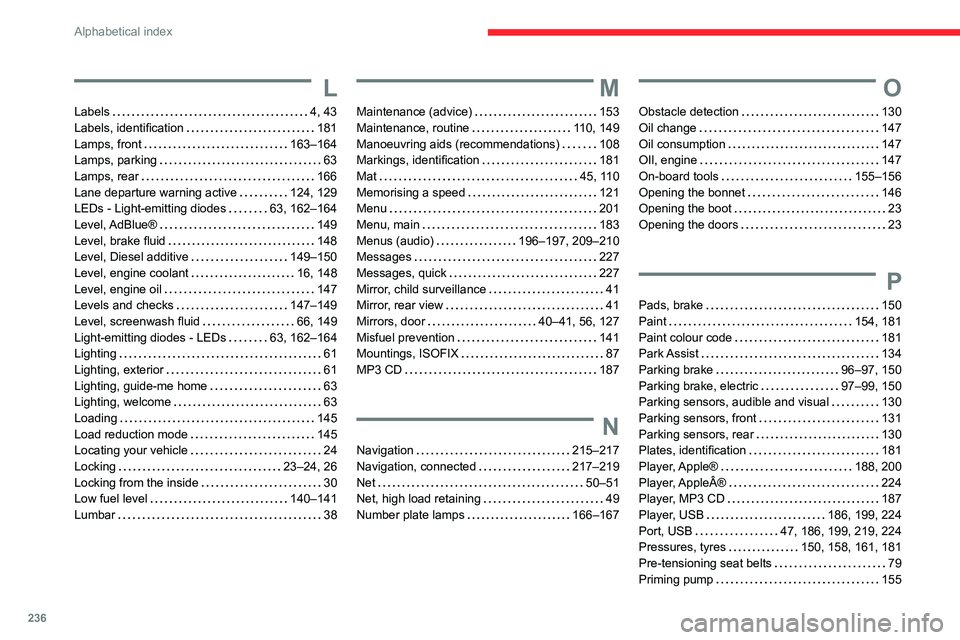brake sensor CITROEN BERLINGO VAN 2021 Handbook (in English)
[x] Cancel search | Manufacturer: CITROEN, Model Year: 2021, Model line: BERLINGO VAN, Model: CITROEN BERLINGO VAN 2021Pages: 260, PDF Size: 7.57 MB
Page 8 of 260

6
Overview
Side switch panel
1.Manual headlamp beam height adjustment
2. DSC / ASR systems
3. Stop & Start
4. Parking sensors
5. Additional heating / ventilation
6. Active Lane Departure Warning System
7. Tyre under-inflation detection
8. Electric child lock
9. Heated windscreen
10. Head-up display
Control on the driver's door
Electric child lock
Central switch panel
1.Hazard warning lamps
2. Locking / unlocking from the inside
3. Hill Assist Descent
4. Eco mode
5. Advanced Grip Control
6. Electric parking brake
7. Starting / switching off the engine
Page 94 of 260

92
Driving
Driving recommendations
► Observe the driving regulations and remain
vigilant whatever the traffic conditions.
►
Monitor your environment and keep your
hands on the wheel to be able to react to
anything that may happen any time.
►
Drive smoothly
, anticipate the need for
braking and maintain a longer safety distance,
especially in bad weather.
►
Stop the vehicle to carry out operations that
require close attention (such as adjustments).
►
During long trips, take a break every two
hours.
Important!
Never leave the engine running in a
closed space without sufficient
ventilation. Internal combustion engines emit
toxic exhaust gases such as carbon
monoxide. Danger of poisoning and death!
In severe wintry conditions (temperature
below -23°C), let the engine run for 4
minutes before moving off, to ensure the
correct operation and durability of the
mechanical components of your vehicle
(engine and gearbox).
Never drive with the parking brake
applied . Risk of overheating and
damage to the braking system!
Do not park the vehicle or leave the
engine running on a flammable
surface (dry grass, dead leaves, etc.). The
exhaust system of your vehicle is very hot,
even several minutes after the engine stops.
Risk of fire!
Never leave a vehicle unattended with
the engine running. If you have to leave
your vehicle with the engine running, apply
the parking brake and put the gearbox into
neutral or position N or P (depending on the
type of gearbox).
Never leave children inside the vehicle
unsupervised.
On flooded roads
We strongly advise against driving on flooded
roads, as this could cause serious damage to
the engine or gearbox, as well as to the electrical
systems of your vehicle.
If you are obliged to drive on a flooded road:
► check that the depth of water does not
exceed 15 cm, taking account of waves that
might be generated by other users,
►
deactivate the Stop & Start function,
►
drive as slowly as possible without stalling. In
all cases, do not exceed 6 mph (10
km/h),
►
do not stop and do not switch off the engine.
On leaving the flooded road, as soon as safety
conditions allow
, make several light brake
applications to dry the brake discs and pads.
If in doubt about the state of your vehicle,
contact a CITROËN dealer or a qualified
workshop.
In case of towing
Driving with a trailer places greater
demands on the towing vehicle and
requires extra care from the driver.
Respect the maximum towable weights.
At altitude: reduce the maximum load by
10% per 1,000 metres of altitude; the density
of the air decreases with altitude and the
performance of the engine reduces.
New vehicle: do not pull a trailer before
having driven at least 620 miles (1,000
kilometres).
If the outside temperature is high, let the
engine idle for 1 to 2 minutes after the
vehicle comes to a stop, to help it to cool.
Before setting off
Nose weight
► Distribute the load in the trailer so that the
heaviest items are as close as possible to the
axle and the nose weight (at the point where it
joins your vehicle) approaches the maximum
permitted without exceeding it.
Tyres
► Check the tyre pressures of the towing
vehicle and of the trailer, observing the
recommended pressures.
Lighting
► Check the electrical signalling on the trailer
and the headlamp beam height of your vehicle.
If a genuine CITROËN towing device is
used, the rear parking sensors will be
deactivated automatically to avoid the audible
signal.
When driving
Cooling
Towing a trailer uphill increases the temperature
of the coolant. The maximum towable load
depends on the gradient and the exterior
temperature. The cooling capacity of the fan
does not increase with engine speed.
► Reduce speed and lower the engine speed,
so as to limit the heating-up.
Page 95 of 260

93
Driving
6Before setting off
Nose weight
► Distribute the load in the trailer so that the
heaviest items are as close as possible to the
axle and the nose weight (at the point where it
joins your vehicle) approaches the maximum
permitted without exceeding it.
Tyres
► Check the tyre pressures of the towing
vehicle and of the trailer , observing the
recommended pressures.
Lighting
► Check the electrical signalling on the trailer
and the headlamp beam height of your vehicle.
If a genuine CITROËN towing device is
used, the rear parking sensors will be
deactivated automatically to avoid the audible
signal.
When driving
Cooling
Towing a trailer uphill increases the temperature
of the coolant. The maximum towable load
depends on the gradient and the exterior
temperature. The cooling capacity of the fan
does not increase with engine speed.
►
Reduce speed and lower the engine speed,
so as to limit the heating-up. In all cases, pay attention to the coolant
temperature.
If this warning lamp and the
STOP
warning lamp come on, stop the vehicle
and switch off the engine as soon as possible.
Brakes
Braking distances are increased when towing a
trailer. To avoid overheating of the brakes, the
use of engine braking is recommended.
Side wind
Bear in mind the increased susceptibility to the
wind that the vehicle will have.
Anti-theft protection
Electronic immobiliser
The remote control contains an electronic chip
which has a special code. When the ignition is
switched on, this code must be recognised in
order for starting to be possible.
A few seconds after switching off the ignition,
this system locks the engine control system,
therefore preventing the engine from being
started in the event of a break-in.
In the event of a fault, you are informed
by illumination of this warning lamp, an
audible signal and a message on the screen.
The vehicle will not start; contact a CITROËN
dealer as soon as possible.
Starting/switching off the
engine
Starting
The parking brake must be applied.
►
With a manual gearbox, shift the gear lever
into neutral, press the clutch pedal to the floor
and keep the pedal down until the engine runs.
►
With
an automatic gearbox, place the selector
in position P then depress the brake pedal.
With the conventional key / With the
remote control key
1. Stop position.
2. Ignition on position.
3. Starting position.
►
Insert the key into the ignition switch.
The
system recognises the starting code.
Page 108 of 260

106
Driving
• With the selector in position D or M: with the
brake pedal released.
•
With the selector in position N
and the brake
pedal released: with the selector at D or M.
•
With the selector in position P
and the brake
pedal depressed: with the selector at R, N,
D or M.
Special cases
The engine will restart automatically if all
conditions for operation are met again and in the
following case.
–
Speed of the vehicle exceeds 2 mph (3
km/h)
(depending on the engine).
In this case, this indicator lamp flashes for
a few seconds, then goes off.
Malfunctions
Depending on the vehicle’s equipment:In the event of a system malfunction, this
warning lamp flashes on the instrument
panel.
The warning lamp in this button flashes and a message appears, accompanied by
an audible signal.
Have the vehicle checked by a CITROËN dealer
or a qualified workshop.
The vehicle stalls in STOP mode
All of the instrument panel warning lamps come
on if there is a fault.
Depending on version, a warning message
may also be displayed, prompting you to place
the gear selector in position N and depress the
brake pedal.
►
Switch off the ignition then start the engine
again with the key or the " ST
ART/STOP" button.
The Stop & Start system requires a 12 V
battery of specific technology and
specification.
All work concerning the battery must be
carried out only by a CITROËN dealer or a
qualified workshop.
Under-inflation detection
This system automatically checks the pressures of the tyres while driving.
It compares the information given by the wheel
speed sensors with reference values, which
must be reinitialised every time the tyre
pressures are adjusted or a wheel changed.
The system triggers an alert as soon as it
detects a drop in the inflation pressure of one or
more tyres.
Under-inflation detection does not
replace the need for vigilance on the part
of the driver.
This system does not avoid the need to
regularly check the tyre pressures (including
the spare wheel) as well as before a long
journey.
Driving with under-inflated tyres, particularly
in adverse conditions (heavy load, high
speed, long journey):
–
worsens road-holding.
–
lengthens braking distances.
–
causes premature wear of the tyres.
–
increases fuel consumption.
The inflation pressures defined for the vehicle can be found on the tyre pressure
label.
For more information on the Identification
markings, refer to the corresponding section.
Checking tyre pressures
This check should be done when the
tyres are "cold" (vehicle stopped for 1 hour or
after a journey of less than 6 miles (10
km) at
moderate speeds).
Otherwise, add 0.3 bar to the pressures
shown on the label.
Snow chains
The system does not have to be
reinitialised after fitting or removing snow
chains.
Spare wheel
The steel spare wheel does not have an
under-inflation detection sensor.
Under-inflation alert
This is signalled by the fixed illumination of this warning lamp, accompanied by an
audible signal and, depending on equipment, the
display of a message.
► Reduce speed immediately, avoid excessive
steering movements and avoid sudden braking.
► Stop the vehicle as soon as it is safe to do
so.
The loss of pressure detected does not always cause visible bulging of the tyre.
Do not rely on just a visual check.
► Using a compressor, such as the one in
the temporary puncture repair kit, check the
pressures of the four tyres when cold.
► If it is not possible to make this check
immediately, drive carefully at reduced speed.
► In the event of a puncture, use the
temporary puncture repair kit or the spare wheel
(depending on equipment).
The alert is kept active until the system is reinitialised.
Reinitialisation
Reinitialise the system after adjusting one or
more tyre pressures and after changing one or
more wheels.
Before reinitialising the system, make
sure that the pressures of the four tyres
Page 129 of 260

127
Driving
6Operating limits
The system goes into standby automatically in
the following cases:
–
ESC deactivated or operation triggered,
–
speed below 40 mph (65
km/h) or greater than
112 mph (180
km/h),
–
electrical connection of a trailer
,
–
use of the "space-saver" spare wheel detected
(as detection is not immediate, deactivation of
the system is recommended),
–
dynamic driving style detected, pressure on
the brake or accelerator pedal,
–
driving where there are no lane markings,
–
activation of the direction indicators,
–
crossing the inside line on a bend,
–
driving in a tight corner
,
–
inactivity by the driver detected during
correction.
During a correction, if the driver is
inactive (not holding the steering wheel
for 10 seconds), a warning message appears.
If the driver remains inactive (not holding
the steering wheel for 2 more seconds), the
correction is interrupted.
The following situations may interfere with the operation of the system or
prevent it from working:
–
insufficient contrast between the road
surface and the shoulders (e.g. shade),
–
lane markings worn, hidden (snow
, mud) or
multiple (roadworks, etc.),
– running close to the vehicle in front (the
lane markings may not be detected),
–
roads that are narrow
, winding, etc.
Risk of undesirable operation
We recommend deactivating the system in the
following driving situations:
–
driving on damaged, unstable or very slippery
(ice) road surfaces,
–
unfavourable weather conditions,
–
driving on a speed circuit,
–
driving on a rolling road.
Deactivation / Activation
► Press this button to deactivate / reactivate the
system at any time.
Deactivation is signalled by the lighting of
the indicator lamp in the button and this
warning lamp in the instrument panel.
The system is automatically reactivated every
time the ignition is switched on.
Malfunction
In the event of a system
malfunction, these warning lamps
come on on the instrument panel, accompanied
by an onscreen message and an audible signal.
Have the system checked by a CITROËN dealer
or a qualified workshop.
Blind Spot Monitoring
System
Refer to the General recommendations on the
use of driving and manoeuvring aids .
This system includes sensors, placed on the
sides of the bumpers, and warns the driver of
the potentially dangerous presence of another
vehicle (car, truck, motorcycle) in the blind spot
areas of their vehicle (areas hidden
from the
driver's field of vision).
Page 235 of 260

233
Alphabetical index
A
ABS 73
Accessories
69, 96
Access to the 3rd row
43
Access to the spare wheel
158–159
Active Safety Brake
122–123
AdBlue®
151
AdBlue® tank
152
Additive, Diesel
149–150
Adjusting headlamps
65
Adjusting head restraints
45
Adjusting seat
38, 43
Adjusting the air distribution
53–54
Adjusting the air flow
53–54
Adjusting the date
205, 229
Adjusting the height and reach of
the steering wheel
40
Adjusting the lumbar support
38
Adjusting the temperature
53–54
Adjusting the time
205, 229
Advanced Grip Control
75–76
Advice on care and maintenance
153
Advice on driving
7, 92
Airbags
80, 82–84
Airbags, curtain
81–82
Airbags, front
80–81, 84
Airbags, lateral
81–82
Air conditioning
52, 54, 55, 57
Air conditioning, digital
56
Air conditioning, dual-zone automatic
53–54
Air conditioning, electronic
(with display screen)
57
Air conditioning, manual
53, 55
Air intake
53–54
Air vents
52
Alarm
33–34
Android Auto connection
220
Anti-lock braking system (ABS)
73
Antitheft / Immobiliser
24
Apple CarPlay connection
201, 219
Applications
220
Armrest
38
Armrest, front
45
Assistance call
69–71
Assistance, emergency braking
73, 123
Audible warning
73
Audio streaming (Bluetooth)
188, 200, 224
B
Battery 144–145, 169, 171–172
Battery, 12 V
149, 169–170
Battery, charging
170–171
Battery, remote control
29, 59
Bench seat, one-piece, fixed
43
Blind spot monitoring system
128
Blind spot monitoring system, active
129
Blind spot sensors
127, 129
BlueHDi
149, 155
Bluetooth
(hands-free)
189–190, 202, 225–226
Bluetooth (telephone) 202–203, 225–226
Bodywork
154
Bonnet
146
Boot lid
26, 28
Bottle holder
45
Brake discs
150
Brake lamps
166
Brakes
150
Braking assistance system
73–74
Braking, automatic emergency
122–123
Braking, dynamic emergency
98–99
Brightness
204
Bulbs
162
Bulbs (changing)
161–162
Bulbs (changing, type)
162
C
Cable, audio 224
Cable, Jack
224
Capacity, fuel tank
140–141
Cap, fuel filler
140–141
Care of the bodywork
154
CD
187, 200
CD, MP3
187, 200
Central locking
23, 26
Changing a bulb
161–164
Changing a fuse
167–169
Changing a wheel
156, 158
Changing a wiper blade
66–67
Changing the remote control battery
29
Page 238 of 260

236
Alphabetical index
L
Labels 4, 43
Labels, identification
181
Lamps, front
163–164
Lamps, parking
63
Lamps, rear
166
Lane departure warning active
124, 129
LEDs - Light-emitting diodes
63, 162–164
Level, AdBlue®
149
Level, brake fluid
148
Level, Diesel additive
149–150
Level, engine coolant
16, 148
Level, engine oil
147
Levels and checks
147–149
Level, screenwash fluid
66, 149
Light-emitting diodes - LEDs
63, 162–164
Lighting
61
Lighting, exterior
61
Lighting, guide-me home
63
Lighting, welcome
63
Loading
145
Load reduction mode
145
Locating your vehicle
24
Locking
23–24, 26
Locking from the inside
30
Low fuel level
140–141
Lumbar
38
M
Maintenance (advice) 153
Maintenance, routine
110, 149
Manoeuvring aids (recommendations)
108
Markings, identification
181
Mat
45, 110
Memorising a speed
121
Menu
201
Menu, main
183
Menus (audio)
196–197, 209–210
Messages
227
Messages, quick
227
Mirror, child surveillance
41
Mirror, rear view
41
Mirrors, door
40–41, 56, 127
Misfuel prevention
141
Mountings, ISOFIX
87
MP3 CD
187
N
Navigation 215–217
Navigation, connected
217–219
Net
50–51
Net, high load retaining
49
Number plate lamps
166–167
O
Obstacle detection 130
Oil change
147
Oil consumption
147
OIl, engine
147
On-board tools
155–156
Opening the bonnet
146
Opening the boot
23
Opening the doors
23
P
Pads, brake 150
Paint
154, 181
Paint colour code
181
Park Assist
134
Parking brake
96–97, 150
Parking brake, electric
97–99, 150
Parking sensors, audible and visual
130
Parking sensors, front
131
Parking sensors, rear
130
Plates, identification
181
Player, Apple®
188, 200
Player, Apple®
224
Player, MP3 CD
187
Player, USB
186, 199, 224
Port, USB
47, 186, 199, 219, 224
Pressures, tyres
150, 158, 161, 181
Pre-tensioning seat belts
79
Priming pump
155